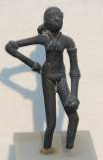Sculpture of India
- Started from Harappa valley civilization in the form of Dancing girl, breaded priest and Terracotta figures.
- Found in time of Mauryan time as Yaksha and Yakshini (Statue at Didarganj) belong to Jain, buddha and hinduism.
- Mention in Tamil text Silappadikaram.
- Found In Mandapa in temples, stupas and Toranas.
Sculptures of Harappan Civilisation
- The Harappan sculptors were extremely adept at handling three-dimensional volumes.
- The most commonly found were seals, bronze figures and potteries.
Seals
- Shapes - square, triangular, rectangular and circular seals were being used.
- Material - Steatite, a soft stone found in the river beds, was the most common material used to make seals. Agate, chert, copper, faience gold, ivory and terracotta seals have also been found.
- Script - pictographic script which is yet to be deciphered, written mostly from right to left, but, bi- directional writing style i.e. right to left on one line and left to right on another line has also been found.
- Animal motifs - unicorn, humped bull, rhinoceros, tiger, elephant, buffalo, bison, goat, markour, ibex, crocodile, etc. No evidence of cows has been found on any seal.
- Seals with symbols similar to ‘Swastika’ design have also been found.
- Seals were primarily used for commercial purposes and helped in communication.
- Seals discovered in Mesopotamia and various sites such as Lothal indicate that seals were extensively used for trade.
- Some seals with a hole on them have been found on dead bodies indicating its use as amulets.
Pashupati Seal
- Steatite seal
- Discovered at Mohenjo-daro
- Depicts a human figure or a deity sitting cross-legged.
- Surrounded by animals. - An elephant and a tiger are there on the left side of the figure while a rhinoceros and a buffalo are seen on the right side. Two antelopes are shown below the seat of the figure.
Bronze Figures
- The bronze statues were made using “lost wax technique” or “Cire Perdue”.
Bronze Dancing Girl
- It is the world’s oldest bronze sculpture.
- Found in Mohenjo-daro.
- This four-inch figure depicts a naked girl wearing only ornaments, which include bangles.
- in the left arm, and amulet and bracelet on the right arm.
- Stands in a ‘tribhanga’ dancing posture with the right hand on her hip.
Terracotta
- Found less in number and crude in shape and form.
- Found mostly in the sites of Gujarat and Kalibangan.
Mother Goddess
- Found in many Indus sites including Harappa.
- It is a crude figure of a standing female adorned with necklaces hanging over prominent breasts.
- She wears a loincloth and a girdle.
- She also wears a fan-shaped headgear.
- The facial features are also shown very crudely and lack finesse.
Bearded Priest
- Made of Steatite.
- Found in Mohenjo-daro.
- Figure of a bearded man, draped in a shawl with trefoil patterns.
- Elongated eyes and half closed as in meditation.
Red sandstone figure of a male torso
- Made of Red sandstone.
- Found in Harappa.
- The torso has a frontal posture with well baked shoulders and a prominent abdomen.
- There are socket holes in the neck and shoulders.
Prominent schools of sculpture art in India
1. Gandhara school
- Originated in modern day Peshawar in North west Punjab region in Pakistan
- Between 50 BC to 500 AD
- Influenced by Greek and romans
- Patronised by Kushana rulers
- Used of blue sandstone and Mud stucco
- Used only for making Buddha and Bodhisattva image
- Buddha image resembled with Apollo (greek God) and showed with Spiritual
- features as half closed eye
- Famous at Taxila University
2. Mathura school
- Flourished near Yamuna basin near Mathura and Sonkh area in 100 BC to 400 BC
- Influenced by all Religion of hinduism,buddhism and jainism
- Use of Spotted Red Sandstone from Bundelkhand area Show resemblance with Yakshas images Patronised by Kushan rulers
- Image were showed with great symbolism like Padampani baddha and Shiva as Linga
3. Amravati school
- Flourished in Nagarjunakonda and Amravati district on the bank of krishna river
- Use of White Marble was prevalence
- Patronised by Satavahana Ruler
- Instead of images,Narrative story making was showed like Jataka story of Buddha




.png)
Comments
Post a Comment